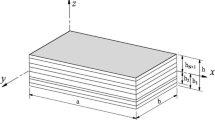Abstract
In this paper a procedure is proposed to calculate the interlaminar shear stresses in layered composite plates. The transverse shear stresses are obtained via the constitutive law and derivatives of some warping functions. For 4-node elements the derivatives of curvatures and strains of the reference surface with respect to the in-plane coordinates are determined through a system of four equations. Hence the equilibrium equations lead to a coupled system of ordinary differential equations, which are solved applying a displacement method. The resulting interlaminar shear stresses are continuous at the layer boundaries. The quality of the obtained results is demonstrated within several plate examples with symmetric and unsymmetric lay-ups. Comparisons with two other approaches using 9-node elements and a solid shell formulation together with a three-dimensional material law show good accuracy and efficiency of the proposed algorithm.
Similar content being viewed by others
References
Auricchio F, Sacco E (1999) A mixed-enhanced finite-element for the analysis of laminated composite plates. Int J Numer Methods Eng 44: 1481–1504
Rohwer K (1992) Application of higher order theories to the bending analysis of layered composite plates. Int J Solids Struct 29: 105–119
Degenhardt R, Rolfes R, Zimmermann R, Rohwer K (2006) COCOMAT-improved MATerial exploitation at safe design of COmposite airframe structures by accurate simulation of COllapse. Compos Struct 73: 175–178
Mittelstedt C, Becker W (2004) Interlaminar stress concentrations in layered structures, Part I: A selective literature survey on the free-edge effect since 1967. J Compos Mater 38: 1037–1062
Marimuthu R, Sundaresan MK, Rao GV (2003) Estimation of interlaminar stresses in laminated plates subjected to transverse loading using three-dimensional mixed finite element formulation the Institution of Engineers(India). Technical J Aerosp Eng 84: 1–8
Klinkel S, Gruttmann F, Wagner W (1999) A continuum based 3D-shell element for laminated structures. Comput Struct 71: 43–62
Klinkel S, Gruttmann F, Wagner W (2006) A robust non-linear solid shell element based on a mixed variational formulation. Comp Meth Appl Mech Eng 195: 179–201
Reddy JN (1987) A generalization of two-dimensional theories of laminated plates. Commun Appl Numer Methods 3: 173–180
Chaudhuri RA (1986) An equilibrium method for prediction of transverse shear stresses in a thick laminated plate. Comput Struct 23: 139–146
Carrera E (1996) C 0 Reissner-Mindlin multilayered plate elements including Zig-Zag and interlaminar stress continuity. Int J Numer Methods Eng 39: 1797–1820
Brank B, Carrera E (2000) Multilayered shell finite element with interlaminar continuous shear stresses: a refinement of the Reissner-Mindlin formulation. Int J Num Meth Eng 48: 843–874
Carrera E (2003) Historical review of Zig-Zag theories for multilayered plates and shells. Appl Mech Rev 56: 237–308
Gruttmann F, Wagner W, Meyer L, Wriggers P (1993) A nonlinear composite shell element with continuous interlaminar stresses. Comput Mech 13: 175–188
Gruttmann F, Wagner W (1994) On the numerical analysis of local effects in composite structures. Compos Struct 29: 1–12
Gruttmann F, Wagner W (1996) Coupling of 2D- and 3D- composite shell elements in linear and nonlinear applications. Comp Meth Appl Mech Eng 129: 271–287
Gruttmann F, Wagner W (1996) Delamination analysis of thin composite structures using a multi-director formulation. In: Topping BHV (eds) Advances in analysis and design. Civil-Comp. Press, Edinburgh, pp 51–59
Robbins DH, Reddy JN (1993) Modelling of thick composites using a layerwise laminate theory. Int J Numer Meth Eng 36: 655–677
Reddy JN (1984) A simple high-order theory for laminated composite plates. J Appl Mech 51: 745–752
Engblom JJ, Ochoa OO (1985) Through-the-thickness stress distribution for laminated plates of advanced composite materials. Int J Num Meth Eng 21: 1759–1776
Reddy JN (1989) On refined computational models of composite laminates. Int J Num Meth Eng 27: 361–382
Rao KM, Meyer-Piening HR (1990) Analysis of thick laminated anisotropic composite plates by the finite element method. Compos Struct 15: 185–213
Topdar P, Sheikh AH, Dhang N (2003) Finite element analysis of composite and sandwich plates using a continuous interlaminar shear stress model. J Sandwich Struct Mater 5: 207–231
Noor AK, Burton WS, Peters JM (1990) Predictor-corrector procedure for stress and free vibration analyses of multilayered composite plates and shells. Comput Meth Appl Mech Eng 82: 341–364
Noor AK, Kim YH, Peters JM (1994) Transverse shear stresses and their sensitivity coefficients in multilayered composite panels. AlAA J 32: 1259–1269
Manjunatha BS, Kant T (1994) On evaluation of transverse stresses in layered symmetric composite and sandwich laminates under flexure. Eng Comput 10: 499–518
Rolfes R, Rohwer K (1997) Improved transverse shear stresses in composite finite elements based on first order shear deformation theory. Int J Num Meth Eng 40: 51–60
Gruttmann F, Taylor RL (1992) Theory and finite element formulation of rubberlike membrane shells using principal stretches. Int J Numer Meth Eng 35: 1111–1126
Gruttmann F, Wagner W (2006) Structural analysis of composite laminates using a mixed hybrid shell element. Comput Mech 37: 479–497
Taylor RL, Feap-manual. http://www.ce.berkeley/~rlt/feap/manual.pdf
Schenk O, Gärtner K (2004) Solving unsymmetric sparse systems of linear equations with PARDISO. J Future Gener Comput Syst 20(3): 475–487
Author information
Authors and Affiliations
Corresponding author
Rights and permissions
About this article
Cite this article
Schürg, M., Wagner, W. & Gruttmann, F. An enhanced FSDT model for the calculation of interlaminar shear stresses in composite plate structures. Comput Mech 44, 765–776 (2009). https://doi.org/10.1007/s00466-009-0410-7
Received:
Accepted:
Published:
Issue Date:
DOI: https://doi.org/10.1007/s00466-009-0410-7




